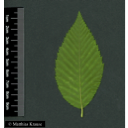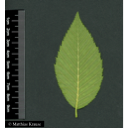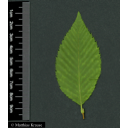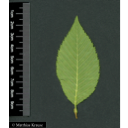Useful information about the taxon (species, subspecies, variety...)
Ostrya japonica Sarg. 1893
Betulaceae
(APG IV)Japanese hop-hornbeam
Taxon concept: The Plant List (2014), version 1.1
Distribution: China, Japan, Korea
Flowering period: V - VII
Ostrya japonica Sarg. - Accepted: Ostrya japonica Sarg. bei The Plant List (2014), version 1.1; Familie: Betulaceae (APG III)
- Life form
- tree
- Leaves
- ovate to lanceolate, irregularly and doubly serrate, lower surface (abaxially) with dense pubescence; petiole 1-1.5 cm long
- Foliage persistence
- deciduous
- Fruits
- ripped nut fruit
- Light conditions
- sunny or partial shade
- Vegetation typ and synecology (plant community)
- temperate mesophytic forests
- Usage
- wood is used for furniture making and for construction
- Bark
- dark grey
- Altidudinal lower limit (sea level in m)
- 1,000
- Altitudinal higher limit (sea level in m)
- 2,800
Erhardt, W., Götz, E., Bödeker, N. & Seybold, S. (2008): Der große Zander. Enzyklopädie der Pflanzennamen. Band 2. Arten und Sorten. Eugen Ulmer KG, Stuttgart (Hohenheim), 18. Aufl., 2103 S.; Global Biodiversity Information Facilty (GBIF). Online Publication: www.gbif.org; Kühn, I. & Klotz, S. (2002): Systematik, Taxonomie und Nomenklatur. In: Klotz, S., Kühn, I., Durka, W. (Hrsg.): BIOLFLOR - Eine Datenbank mit biologisch-ökologischen Merkmalen zur Flora von Deutschland. Schriftenreihe für Vegetationskunde. Bonn. See: http://www.ufz.de/biolflor/taxonomie/taxonomie.jsp?ID_Taxonomie=5; The IUCN Red List of Threatened Species. www.iucnredlist.org;
Diese Webseite verwendet Google Maps, um Karten und Standorte von Pflanzen in den Hohenheimer Gärten anzuzeigen. Dadurch werden unter Umständen Daten an Google weitergeleitet, was mit einer Verarbeitung Ihrer personenbezogenen Daten verbunden sein kann. Die Datenschutzerklärung von Google finden Sie hier: Datenschutzerklärung von Google
| Sex | Standort | Accession number | Planting year | Donation | IPEN | Lat. | Long. |
|---|---|---|---|---|---|---|---|
| Klimabäume Hohenheim West | KLB-331-20489 | XX-0-HOH-KLB-331-20489 | 0 | 0 | |||
| Klimabäume Hohenheim West | KLB-332-20489 | XX-0-HOH-KLB-332-20489 | 0 | 0 | |||
| Klimabäume Hohenheim West | KLB-333-20489 | XX-0-HOH-KLB-333-20489 | 0 | 0 | |||
| Klimabäume Hohenheim West | KLB-334-20489 | XX-0-HOH-KLB-334-20489 | 0 | 0 | |||
| Klimabäume Hohenheim West | KLB-335-20489 | XX-0-HOH-KLB-335-20489 | 0 | 0 | |||
| Parzelle F | EG-F-079-18774 | 2010 | XX-0-HOH-EG-F-079-18774 | 48,7097889871 | 9,205366311 | ||
| Parzelle L | EG-L-111-18773 | 1925 | XX-0-HOH-EG-L-111-18773 | 48,7082574023 | 9,2076658914 |




